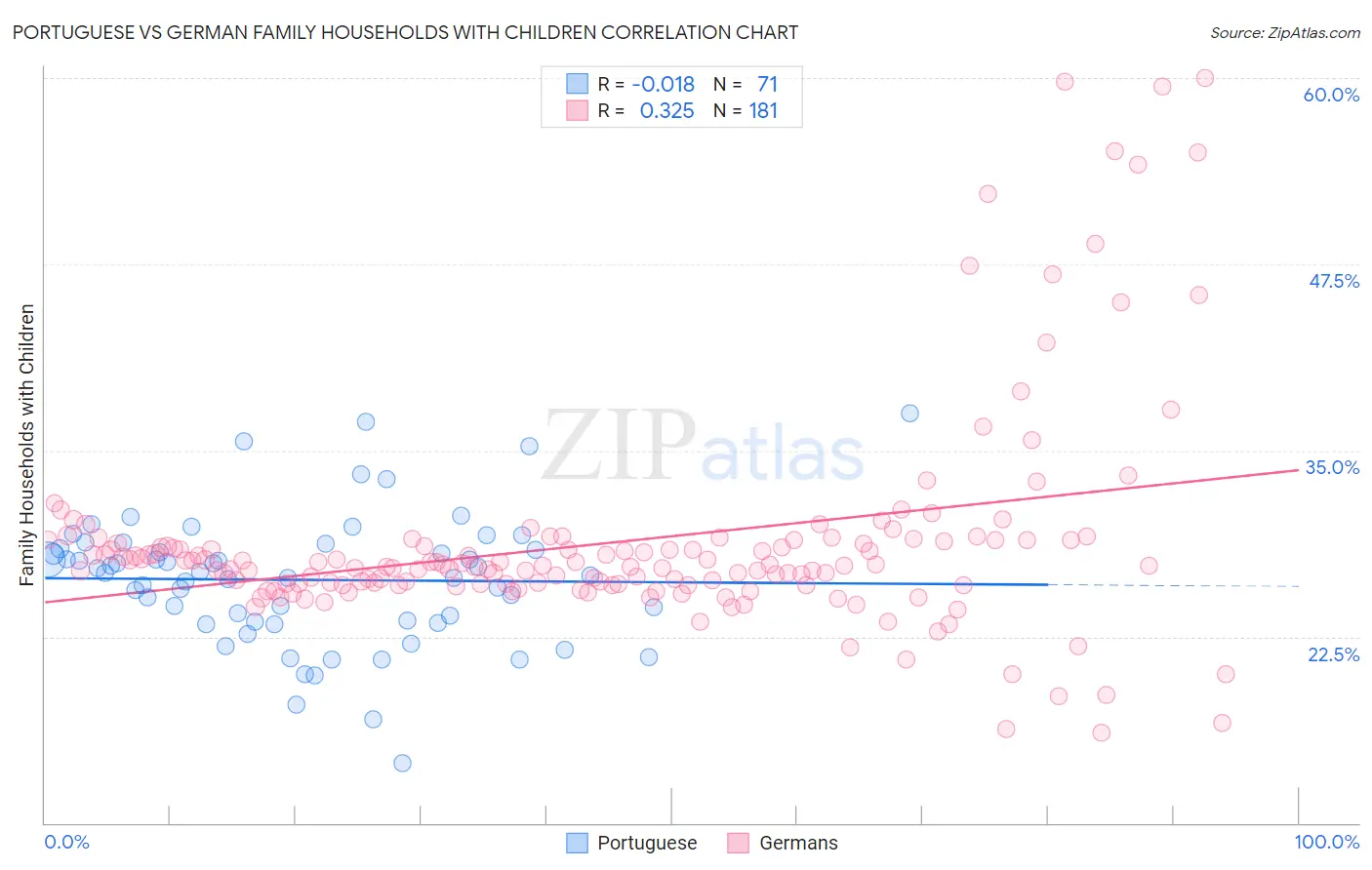Portuguese vs German Family Households with Children
COMPARE
Portuguese
German
Family Households with Children
Family Households with Children Comparison
Portuguese
Germans
27.6%
FAMILY HOUSEHOLDS WITH CHILDREN
77.8/ 100
METRIC RATING
151st/ 347
METRIC RANK
27.1%
FAMILY HOUSEHOLDS WITH CHILDREN
8.7/ 100
METRIC RATING
224th/ 347
METRIC RANK
Portuguese vs German Family Households with Children Correlation Chart
The statistical analysis conducted on geographies consisting of 449,747,552 people shows no correlation between the proportion of Portuguese and percentage of family households with children in the United States with a correlation coefficient (R) of -0.018 and weighted average of 27.6%. Similarly, the statistical analysis conducted on geographies consisting of 579,972,630 people shows a mild positive correlation between the proportion of Germans and percentage of family households with children in the United States with a correlation coefficient (R) of 0.325 and weighted average of 27.1%, a difference of 2.0%.

Family Households with Children Correlation Summary
| Measurement | Portuguese | German |
| Minimum | 14.0% | 16.1% |
| Maximum | 37.5% | 60.0% |
| Range | 23.5% | 43.9% |
| Mean | 26.3% | 28.8% |
| Median | 26.7% | 27.3% |
| Interquartile 25% (IQ1) | 23.5% | 26.0% |
| Interquartile 75% (IQ3) | 28.4% | 29.0% |
| Interquartile Range (IQR) | 4.9% | 3.0% |
| Standard Deviation (Sample) | 4.4% | 7.2% |
| Standard Deviation (Population) | 4.3% | 7.2% |
Similar Demographics by Family Households with Children
Demographics Similar to Portuguese by Family Households with Children
In terms of family households with children, the demographic groups most similar to Portuguese are Argentinean (27.6%, a difference of 0.020%), Ethiopian (27.6%, a difference of 0.030%), Immigrants from Moldova (27.6%, a difference of 0.040%), Osage (27.6%, a difference of 0.040%), and Menominee (27.6%, a difference of 0.040%).
| Demographics | Rating | Rank | Family Households with Children |
| Brazilians | 79.6 /100 | #144 | Good 27.7% |
| Immigrants | Chile | 79.5 /100 | #145 | Good 27.7% |
| Basques | 79.5 /100 | #146 | Good 27.7% |
| Immigrants | Moldova | 79.1 /100 | #147 | Good 27.6% |
| Osage | 79.0 /100 | #148 | Good 27.6% |
| Menominee | 78.9 /100 | #149 | Good 27.6% |
| Argentineans | 78.5 /100 | #150 | Good 27.6% |
| Portuguese | 77.8 /100 | #151 | Good 27.6% |
| Ethiopians | 77.0 /100 | #152 | Good 27.6% |
| Immigrants | Cabo Verde | 75.6 /100 | #153 | Good 27.6% |
| Icelanders | 75.3 /100 | #154 | Good 27.6% |
| Comanche | 74.8 /100 | #155 | Good 27.6% |
| Hungarians | 74.6 /100 | #156 | Good 27.6% |
| Indians (Asian) | 71.6 /100 | #157 | Good 27.6% |
| Romanians | 70.8 /100 | #158 | Good 27.6% |
Demographics Similar to Germans by Family Households with Children
In terms of family households with children, the demographic groups most similar to Germans are Pima (27.1%, a difference of 0.030%), Paraguayan (27.1%, a difference of 0.050%), New Zealander (27.1%, a difference of 0.060%), Austrian (27.1%, a difference of 0.080%), and Canadian (27.1%, a difference of 0.090%).
| Demographics | Rating | Rank | Family Households with Children |
| U.S. Virgin Islanders | 12.1 /100 | #217 | Poor 27.1% |
| Greeks | 11.4 /100 | #218 | Poor 27.1% |
| Immigrants | Japan | 10.7 /100 | #219 | Poor 27.1% |
| Austrians | 9.9 /100 | #220 | Tragic 27.1% |
| New Zealanders | 9.6 /100 | #221 | Tragic 27.1% |
| Paraguayans | 9.4 /100 | #222 | Tragic 27.1% |
| Pima | 9.2 /100 | #223 | Tragic 27.1% |
| Germans | 8.7 /100 | #224 | Tragic 27.1% |
| Canadians | 7.5 /100 | #225 | Tragic 27.1% |
| Czechoslovakians | 6.6 /100 | #226 | Tragic 27.0% |
| Tsimshian | 6.6 /100 | #227 | Tragic 27.0% |
| Scottish | 6.5 /100 | #228 | Tragic 27.0% |
| Immigrants | Caribbean | 6.3 /100 | #229 | Tragic 27.0% |
| Bulgarians | 5.8 /100 | #230 | Tragic 27.0% |
| Luxembourgers | 5.5 /100 | #231 | Tragic 27.0% |